Abstract
X-ray response performances of a p-NiO/β-Ga2O3 hetero-junction diode (HJD) X-ray detector were studied before and after γ-ray irradiation at −200 V, with a total dose of 13.5 kGy(Si). The response performances of the HJD X-ray detector were influenced by the trap-assistant conductive process of the HJD under reverse bias, which exhibited an increasing net (response) current, nonlinearity, and a long response time. After irradiation, the Poole–Frenkel emission (PFE) dominated the leakage current of HJDs due to the higher electric field caused by the increased net carrier concentration of β-Ga2O3. This conductive process weakened the performance of the HJD X-ray detector in terms of sensitivity, output linearity, and response speed. This study provided valuable insights into the radiation damage and performance degradation mechanisms of Ga2O3-based radiation detectors and offered guidance on improving the reliability and stability of these radiation detectors.
1. Introduction
The ultra-wide bandgap semiconductor gallium oxide (Ga2O3) has the characteristics of low intrinsic carrier concentration and high irradiation resistance, which make Ga2O3-based devices promising prospects in the applications of high-energy physics, nuclear reaction monitoring, and space electronics [1,2,3,4,5]. Nowadays, Ga2O3-based radiation detectors have drawn great attention and have been designed for neutrons, charged particles, and X-ray detection [6,7,8,9,10]. However, when these radiation detectors are exposed to radiation during operation, their performance degrades. Although the effects of radiation on Ga2O3-based devices have been widely investigated recently [11,12,13,14,15], their impact on the performance of radiation detectors has rarely been studied. Gamma rays (γ-rays) are a type of high-energy electromagnetic radiation produced by the de-excitation of atomic nuclei. Their prevalent presence in the universe and nuclear fusion environments, coupled with the challenges associated with effective shielding, has led to significant interest in studying the total dose radiation damage inflicted by γ-rays on semiconductor devices [16,17,18]. Therefore, studying the degradation of detector performance in a γ radiation environment helps explore the service life of detectors in space and radiation monitoring applications.
In this paper, a p-NiO/β-Ga2O3 hetero-junction diode (HJD) X-ray detector was fabricated and tested under X-ray irradiation before and after gamma ray exposure. The gamma radiation was provided by a 60Co source, which provided a dose rate of 0.5 Gy(Si)∙s−1 in the point of space where the detector was placed. The detector was irradiated at −200 V, the maximum value allowed by the Keysight B2902, which is also the operating bias voltage during X-ray detection. This online mode, which indicates that the detector was biased under irradiation, simulated an actual monitoring environment for the radiation detector. The current-voltage (I-V), capacitance-voltage (C-V), and temperature-dependent I-V (I-V-T) characteristics of the HJD X-ray detector were under dark conditions before and after irradiation. In addition, the X-ray response performances to X-ray dose rates and switching modes were conducted.
2. Experiments
A β-Ga2O3 sample from NCT company, with a lightly Si-doped epitaxial layer (grown by the hydride vapor phase epitaxy (HVPE) method) grown on a Sn-doped β-Ga2O3 (001)-oriented substrate (650 μm, with Sn doping concentration > 2 × 1018 cm−3), was used in this study. The p-NiO/β-Ga2O3 HJD X-ray detector was fabricated with an incorporated guard ring to reduce the high electric field at the edges of metal contacts. Figure 1a shows the preparation process of NiO/β-Ga2O3 HJDs. Initially, the samples were cleaned with acetone and isopropanol, followed by a four-cycle de-ionized (DI) water rinse and N2 blow drying. Subsequently, a Ti/Au metal layer (50 nm/100 nm) was deposited by electron beam evaporation as the cathode, followed by rapid thermal annealing at 470 °C for 60 s in N2 ambient to form ohmic contacts. A SiO2 layer was then deposited via plasma-enhanced chemical vapor deposition (PECVD) at 350 °C for 8 min as an implantation mask. The incorporated guard ring (GR) pattern was formed by photolithography, and triple-energy N⁺⁺ ion implantation was performed with doses of 8 × 1012 cm−2 (30 keV), 2.3 × 1013 cm−2 (160 keV), and 3 × 1013 cm−2 (360 keV), targeting a box-like doping profile (1.5 × 1018 cm−3, 0.5–0.6 μm in depth). The SiO2 mask and photoresist (PR) were subsequently removed by buffered oxide etch solution (BOE) etching. Then, a second photolithography step patterned the NiO region, followed by a 200 nm NiO film deposition via magnetron sputtering (5 mTorr, Ar/O2 = 1:1, 130 W) and lift-off process. Post-deposition annealing at 300 °C for 60 s in O2 ambient was applied to enhance NiO crystallinity. Finally, the anode structure, a 500 μm rounded-corner square (30 μm in radius), was defined by aligned photolithography, and a Ni/Au metal layer (50 nm/150 nm) was deposited via electron beam evaporation and lift-off to complete the device. After fabrication, the detector was packaged on a printed circuit board (PCB) to facilitate testing, as shown in Figure 1b.
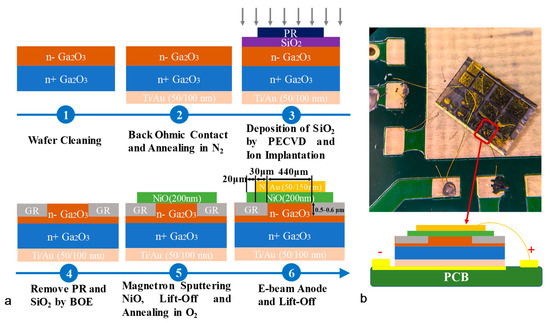
Figure 1.
(a) The preparation process of NiO/β-Ga2O3 HJD X-ray detectors with N+-implanted incorporated guard ring. (b) The diagram of the fabricated detector packaged on a PCB.
The irradiation and radiation response experiments were conducted in a shielding room at room temperature. The HJD X-ray detector was designated for γ-ray irradiation with a total dose of 13.5 kGy(Si) at a bias voltage of −200 V. The γ-ray was generated by the 60Co source provided by the Northwest Institute of Nuclear Technology (NINT), and the dose rate at the irradiated HJD X-ray detector was 0.5 Gy(Si)∙s−1. Before and after the γ-ray irradiation, the typical current-voltage (I-V) and capacitance-voltage (C-V) characterizations in dark conditions and X-ray response performances of the HJD X-ray detector were measured by a Source Measure Unit (B2902A, Agilent). A hot plate (CH600-190) was used in the I-V-T measurement to provide the temperature for the detector. The X-ray source used in this study was a miniature X-ray tube with a tungsten anode (60 kV, 12W X-ray source, Moxtek, USA) provided by the NINT, which generates a wide continuous spectrum composed by the bremsstrahlung and the characteristic L-lines of tungsten. The average photon energy of X-ray photons was at around 10 keV when the X-ray tube accelerating voltage was set at 30 kV, and the X-ray dose rate was calibrated by Unidos dosimeter to be 383 mGy∙s−1 for air at a distance of 2 cm from the source. In addition, for the γ-ray and X-ray irradiation experiments, the detector was irradiated from the anode side. In this paper, all test results following irradiation refer specifically to on-line irradiation.
3. Results and Discussion
Figure 2 displays the typical current-voltage (I-V) characteristics of pristine and irradiated HJDs at 300 K. The HJD X-ray detector exhibited similar I-V curves before and after γ-ray irradiation. Slight changes in the I-V curves of the HJD X-ray detector were observed after irradiation, such as higher forward current density, turn-on voltage, and leakage current density at high reversed bias. These results exhibited the opposite phenomenon against the study of the offline γ radiation effects (offline means the devices were irradiated without applied bias voltages) on the Ga2O3 diodes [19,20,21], which obtained higher on-resistance and lower leakage current after irradiation.
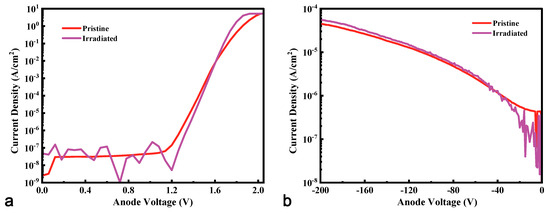
Figure 2.
Typical (a) forward and (b) reverse I-V characteristics of pristine and irradiated HJDs X-ray detectors at 300 K.
The C-V measurement was conducted to determine the reasons for the changes in the I-V curves shown in Figure 2. Figure 3a illustrates the typical C-V characteristics of the pristine and irradiated HJDs measured at 100 kHz. According to Equation (1), the net carrier concentration (ND-NA) can be extracted from the C−2-V curves shown in Figure 3b. Given the high doping concentration of ~1019 cm−3 for the NiO layer, the extracted net carrier concentration was mainly attributed to that of β-Ga2O3. Thus, the net carrier concentration of Ga2O3 increased from 1.38 × 1016 cm−3 to 3.07 × 1016 cm−3 after 13.5 kGy(Si) γ-ray irradiation, which was opposite to the decreased net carrier concentration revealed by offline radiation [19,20,21]. The difference between online and offline irradiation results was attributed to an extra electric field within the HJD detector when online irradiation occurred, and, in this case, the radiation-generated current exacerbated the impact of defects in the interface of NiO/Ga2O3 and the materials introduced by irradiation [22]. Consequently, the increased net carrier concentration of the β-Ga2O3 epitaxial layer caused by γ-ray irradiation reduced the on-resistance and increased the forward current. However, few papers have reported the increasing net carrier concentration after γ-ray irradiation, and the radiation damage mechanism in Ga2O3 should be studied further. In addition, the increased net carrier concentration in n-type Ga2O3 might have left up the fermi level of the electron and increased the barrier height between the p-NiO and n-Ga2O3, leading to a larger turn-on voltage after irradiation.
where C is the measured capacitance of the HJD detector, NA is the acceptor concentration of β-Ga2O3, ND is the donor concentration of Ga2O3, A is the effective area of the HJD, ε0 is the permittivity of vacuum, and εr is the static dielectric constant of the β-Ga2O3.
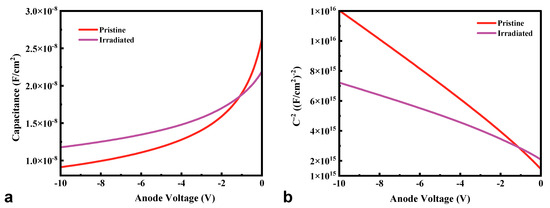
Figure 3.
(a) Typical C-V and (b) C−2-V characteristics of the pristine and irradiated HJDs X-ray detectors at 300 K.
The X-ray response current was measured under the sweep mode from 0 V to −200 V, with a sampling rate of 1 V/60 ms. Figure 4 shows the net current (Inet) of the HJD X-ray detector at various dose rates before and after irradiation, where the net current was defined as the output current under X-ray illumination (Ix-ray) minus the dark current (Idark). The net current of the HJD X-ray detector increases with the bias voltage increasing both before and after irradiation. This phenomenon was observed in the Pt/Ga2O3 SBD X-ray detector [7] and the p-NiO/β-Ga2O3 HJD X-ray detector [23] without an incorporated guard ring, which was associated with leakage current due to the photoconductive mechanism caused by traps/defects in the Ga2O3 material. Moreover, because the net carrier concentration increased after irradiation, the electric field in the irradiated detector was higher than that in the pristine detector, resulting in a shorter width of the depletion region of the irradiated detector. Therefore, the irradiated detector showed an increased net current associated with photoconductive gain at bias voltages from 0 V to 200 V due to the high electric field. In contrast, the pristine detector showed transparent photoconductive gain only at higher bias voltages and dose rates, which could be attributed to the space charge effects [24].
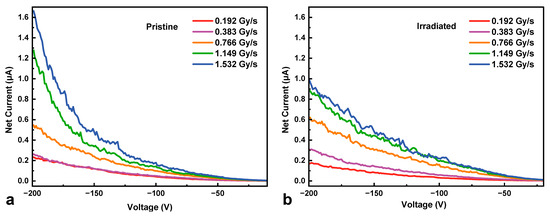
Figure 4.
The net current of (a) pristine and (b) irradiated HJD X-ray detectors at various dose rates against bias voltages.
Figure 5 shows the light-to-dark ratio of the HJD X-ray detector before and after irradiation as a function of the X-ray dose rate from 0.192 Gy∙s−1 to 1.532 Gy∙s−1. The irradiated HJD detector exhibited a higher light-to-dark ratio at low bias voltages while showing a lower light-to-dark ratio at high bias voltages than the pristine detector. Specifically, before irradiation, the pristine detector exhibited a non-monotonic light-to-dark ratio curve. In section Ⅰ, the net current increased with the width of the depletion region and faster than the low leakage current, and the light-to-dark ratio increased with the bias voltages. As the voltage increased, the rate of leakage current also rose, leading to a decrease in the light-to-dark ratio in section Ⅱ. When the bias voltage reached around −130 V, a high net current was obtained at high dose rates of 1.149 Gy∙s−1 and 1.532 Gy∙s−1, leading to an increased light-to-dark ratio with the bias voltages in section Ⅲ. In contrast, the irradiated HJD detector exhibited a decreased light-to-dark ratio overall. At low bias voltages (section I), the pristine detector showed a lower ratio than that of the irradiated detector because γ-ray irradiation caused an increase in the barrier height between p-NiO and n-Ga2O3, resulting in a decrease in leakage current. However, the net current of the irradiated device was restricted, and the leakage current continued to rise, leading to a steady decline in the light-to-dark ratio as the bias voltage increased.
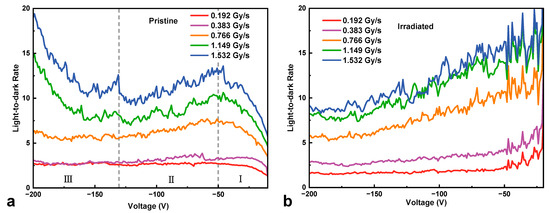
Figure 5.
The light-to-dark ratio of (a) pristine and (b) irradiated HJD X-ray detectors at various dose rates against bias voltages.
To quantitatively evaluate the X-ray detection performances of the HJD X-ray detector before and after irradiation, the sensitivity (S) and the noise-equivalent dose rate (NED) were further calculated. The sensitivity is defined as the ratio between the net current and the incident X-ray dose rate reaching the detector (D) [23]:
The noise-equivalent dose rate is defined as the incident X-ray dose rate that gives a signal-to-noise ratio of one in a 1 Hz bandwidth, which is a measure of the detection limitation of the detector and can be described by the following Equation (3) [23], where Idark is the dark current (leakage current) of the detector, and q is the electron charge:
Figure 6 and Figure 7 plot the sensitivity and noise-equivalent dose rate versus reverse bias voltage at various dose rates from 0.192 Gy∙s−1 to 1.532 Gy∙s−1 for the HJD X-ray detectors before and after irradiation, respectively. The sensitivity of the HJD X-ray detector increased with the bias voltage before and after irradiation. Between the biased voltages from 0 to −160 V, the discrepancy of the sensitivity curve of the pristine detector at high dose rates was less than that of the net current, indicating a good linear relationship between net current and X-ray dose rates. The curves separated at bias voltages from −160 V to −200 V, and the output linearity was broken, which was associated with the trap-related photoconductive current and space charge effects. In contrast, for the HJD X-ray detector after irradiation, the sensitivity curves exhibited a clear difference, meaning that a sub-linear output occurred. The pristine HJD detectors exhibited linear outputs below −100 V, and the irradiated HJD detectors did not exhibit good linear outputs at various bias voltages. Hence, they are not suitable for X-ray dose rate detection. Moreover, attributed to the low dark current of the HJD X-ray detector, the NED decreased with bias voltages before and after irradiation. The NED of the irradiated HJD X-ray detector was higher than that before irradiation because the sensitivity decreased after the γ-ray irradiation. In addition, Figure 8 shows the net currents against X-ray dose rates of the pristine and irradiated HJD X-ray detectors at various bias voltages. The pristine detector exhibited sub-linearity only at a high bias voltage of −200 V. In comparison, the irradiated detector exhibited sub-linearity during the range from 0 V to −200 V, showing consistency with previous analysis.
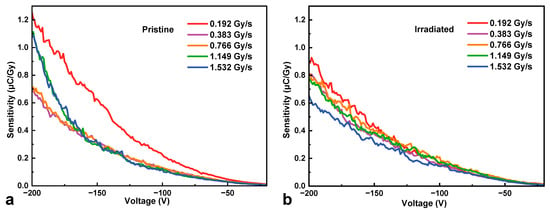
Figure 6.
Sensitivity of (a) pristine and (b) irradiated HJD X-ray detectors at various dose rates against bias voltages.
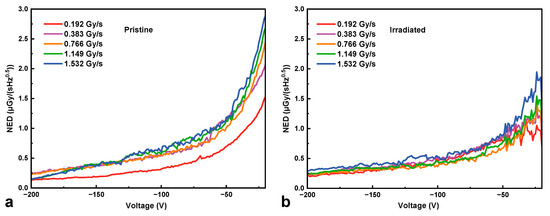
Figure 7.
The noise equivalent dose rate (NED) of (a) pristine and (b) irradiated HJD X-ray detectors at various dose rates against bias voltages.
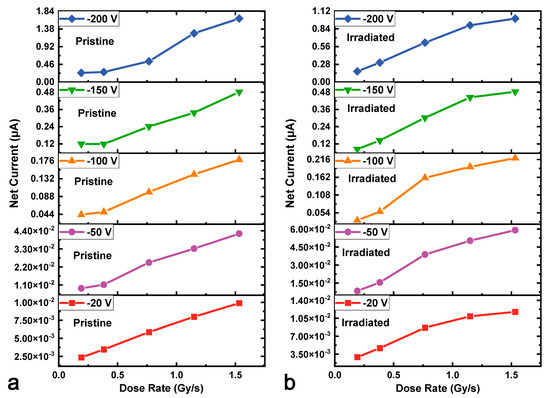
Figure 8.
The net currents against X-ray dose rates of the (a) pristine and (b) irradiated HJD X-ray detectors at various bias voltages.
Figure 9 reveals the transient response of the pristine and irradiated HJD X-ray detectors under switching X-ray illumination with a switching period of 10 s and a sampling rate of 20 ms. When the detector was biased at 0 V, the response current was equal to the photovoltaic current. In this mode, the response current was determined by the pn junction quality. It was clear that, after the γ-ray irradiation, the HJD X-ray detector exhibited a worse response to the switching X-ray at 0 V, meaning a worse junction characteristic of the HJD device caused by the irradiation. Moreover, The HJD before and after irradiation exhibited stable transient responses to the switching of X-ray illumination when biased at −200 V. Figure 9c,d show the absolute value of response current. However, the response time of the detector at −200 V was influenced by the photoconductive effect [7,19]. In this mode, the capture and release of the photo-generated carriers by the deep-level traps have a specific lifetime, leading to a relatively long response time. To study the trap-related time constant (τ) of the HJD X-ray detectors before and after irradiation, the fitting curve was performed at the dose rate of 0.766 Gy∙s−1 using exponential decay functions [25]:
where I(t) is the response current with a function of time of the HJD detector, t is the time, t0 is the initial time when the X-ray illumination is turned on or off, I0 is the steady current with/without X-ray illumination of the HJD detector, τ is the time constant, and I is the coefficient of time response for the τ.

Figure 9.
The transient response of the pristine and irradiated HJD X-ray detectors to the switching of X-ray illumination at biases of (a,b) 0 V and (c,d) −200 V.
Figure 10 shows the fitting curves in one period of the HJD X-ray detector before and after irradiation. Two different time constants are obtained for both response curves to reveal the factors that affected the response/recovery time of the detector, where the response time is defined as the duration time required for the current to increase from 10% to 90% of the difference between the maximum and minimum currents. Conversely, the recovery current is defined as the time it takes for the current to decrease from 90% to 10% of that same difference. For the pristine detector, the response time constants were 0.60 s and 2.10 s with the coefficients 0.73 and 0.13, and the recovery time constants were 0.27 s and 3.23 s with the coefficients 0.99 and 0.37. For the irradiated detector, the response time constants were 0.24 s and 1.61 s with the coefficients 0.29 and 0.41, and the recovery time constants were 0.31 s and 3.81 s with the coefficients 0.55 and 0.32. More fitting information can be found in Table 1. Although the response time constants of the pristine detector seem longer than the irradiated detector, the coefficient of the short constant of the pristine detector was larger, leading to a faster response time. The longer response time indicated that the photoconductive mode was enhanced after the γ-ray irradiation. This result might be caused by the higher electric field in the irradiated detector due to the increased net carrier concentration or new type of traps generated by the γ-ray irradiation, which should be studied further.

Figure 10.
The transient response and the fitting curves of the (a) pristine and (b) irradiated HJD X-ray detectors to the switching of X-ray illumination at biases of −200 V in one period.

Table 1.
The response/recovery time of the HJD detector before and after radiation.
In our previous study [7,23,25], the long-time constant-associated leakage current at high bias voltages mainly contributed to the electric-field-enhanced thermal emission process, such as the Poole–Frenkel emission (PFE). In this case, the reverse I-V-T characteristics of the HJD X-ray detector from 0 V to −200 V before and after irradiation were measured. The fitting results indicate that the PFE model was not suitable for the pristine detector but suitable for the irradiated detector. Figure 11a plots the J/E vs. E0.5 curve of the irradiated detector, according to the following Equation (5) [26]. To extract the relevant parameters in Equation (7) or (8) [15,26], m(t) and b(t) of the pristine and irradiated detectors are also plotted in Figure 11b,c. After the linear fitting process, the ε∞ and qϕt were calculated, as shown in Table 2.
where Eb is the max electric field in the p-NiO/β-Ga2O3 HJD interface, qϕt is the barrier height of electron emission from the trap states, ε0 is the permittivity of vacuum, ε∞ is the high-frequency relative dielectric constant, q is the electron charge, k is the Boltzmann constant, T is the temperature, and C is a constant.

Figure 11.
(a) The reverse I-V-T characteristics of the irradiated HJD X-ray detectors measured in a temperature range of 300 K to 450 K. (b) The m(T) curves and (c) the b(T) curves, as functions of q/kT for the measured irradiated HJD X-ray detectors (blue region).

Table 2.
Extracted PFE parameters of the irradiated detector.
After the γ-ray irradiation, the Eb was increased due to the increased net carrier concentration of β-Ga2O3, and, thereby, the PFE process was enhanced. The Arrhenius plot of m(t) versus 1/kT allows us to estimate the high-frequency relative dielectric constant. The extracted ε∞ after irradiation was 2.27, close to the commonly used value of 3.60 [27], and the extracted energy level of the electron trap was located at 1.07 eV below the minimum value of the conduction band (Ec) of β-Ga2O3 material. This trap was considered the primary trap state causing the PFE process [28] and was usually associated with donor-like oxygen divacancies in β-Ga2O3 [29].
4. Conclusions
In this study, a p-NiO/β-Ga2O3 HJD X-ray detector was tested under X-ray illumination before and after an online 13.5 kGy(Si) γ-ray irradiation at bias at −200 V. The X-ray response of the HJD X-ray detector was influenced by the trap-associated leakage current mechanism before and after irradiation. For instance, the net (response) current of the detector increased with bias voltages much faster than the expanding rate of the depletion region of HJD, and the output linearity against X-ray dose rates and response time characteristics worsened. Moreover, after irradiation, the net carrier concentration of β-Ga2O3 increased from 1.38 × 1016 cm−3 to 3.07 × 1016 cm−3, leading to a lower on-resistance, a larger barrier height of the HJD and a shorter width of the depletion region at a specific bias voltage. Thus, the reverse leakage current at low bias voltage was suppressed but increased at higher bias voltage due to the strengthening of the electric field. As a consequence, the PFE process was enhanced after the γ-ray irradiation. However, the underlying mechanisms for Ga2O3-based devices remain to be further investigated. In addition, the sensitivity of the HJD X-ray detector was lower at −200 V. The nonlinearity outputs against X-ray dose rates were observed from 0 V to −200 V. In addition, the transient response to switching X-ray illumination of the HJD X-ray detector was also degraded after irradiation; the response noise at 0 V increased, and the response time at −200 V increased from 2.92 s to 4.37 s. In short, the net carrier concentration of β-Ga2O3 increased, and the trap (Ec—1.07 eV of β-Ga2O3 material)-associated PFE process enhanced after the γ-ray irradiation, limiting the sensitivity, linearity, and transient response performances of the HJD X-ray detector. In order to better improve the service life of the HJD X-ray detector in the irradiated environment, it is necessary to study the method of inhibiting the leakage current related to trap behavior.
Author Contributions
Conceptualization, L.Z. and L.C.; Methodology, S.Z., X.S., H.C., X.L. and L.C.; Validation, Y.D., Y.L. and X.L.; Formal analysis, S.Z., Z.C. and H.C.; Resources, T.B., X.S., L.C. and L.M.; Data curation, S.Z., Z.C. and H.C.; Writing—original draft, X.O. (Xiao Ouyang); Writing—review & editing, L.Z.; Visualization, X.O. (Xiao Ouyang); Supervision, X.O. (Xiaoping Ouyang); Project administration, L.Z., X.S. and X.O. (Xiaoping Ouyang); Funding acquisition, X.O. (Xiao Ouyang) and L.Z. All authors have read and agreed to the published version of the manuscript.
Funding
This study was supported by the National Natural Science Foundation of China (Grant No. 12205016 and No. 62204198), the Young Elite Scientists Sponsorship Program by CAST (No. 2023QNRC001), and the State Key Laboratory of Wide-Bandgap Semiconductor Devices and Integrated Technology (Grant No. 2413S121).
Data Availability Statement
The original contributions presented in this study are included in this article, and further inquiries can be directed to the corresponding author.
Acknowledgments
Thanks to Mingchao Yang and Xuhui Wang in the School of Microelectronics, Xi’an Jiaotong University, for providing us with the testing equipment.
Conflicts of Interest
The authors declare no conflicts of interest.
References
- Sasaki, K. Prospects for β-Ga2O3: Now and into the future. Appl. Phys. Express 2024, 17, 090101. [Google Scholar] [CrossRef]
- Pearton, S.J.; Yang, J.; Cary, P.H., IV; Ren, F.; Kim, J.; Tadjer, M.J.; Mastro, M.A. A review of Ga2O3 materials, processing, and devices. Appl. Phys. Rev. 2018, 5, 011301. [Google Scholar] [CrossRef]
- Kim, J.; Pearton, S.J.; Fares, C.; Yang, J.; Ren, F.; Kim, S.; Polyakov, A.Y. Radiation damage effects in Ga2O3 materials and devices. J. Mater. Chem. C 2019, 7, 10. [Google Scholar] [CrossRef]
- Mastro, M.A.; Kuramata, A.; Calkins, J.; Kim, J.; Ren, F.; Pearton, S.J. Perspective—Opportunities and Future Directions for Ga2O3. ECS J. Solid State Sci. Technol. 2017, 6, P356–P359. [Google Scholar] [CrossRef]
- Prasad, C.V.; Labed, M.; Shaikh, M.T.A.S.; Min, J.Y.; Nguyen, T.H.V.; Song, W.; Kim, K.J.; Rim, Y.S. Ga2O3-based X-ray detector and scintillators: A review. Mater. Today Phys. 2023, 35, 101095. [Google Scholar] [CrossRef]
- Szalkai, D.; Galazka, Z.; Irmscher, K.; Tutto, P.; Klix, A.; Gehre, D. β-Ga2O3 Solid-State Devices for Fast Neutron Detection. IEEE Trans. Nucl. Sci. 2017, 64, 1574–1579. [Google Scholar] [CrossRef]
- Lu, X.; Zhou, L.; Chen, L.; Ouyang, X.; Liu, B.; Xu, J.; Tang, H. Schottky X-ray detectors based on a bulk β-Ga2O3 substrate. Appl. Phys. Lett. 2018, 112, 103502. [Google Scholar] [CrossRef]
- Hany, I.; Yang, G.; Chung, C.-C. Fast X-ray detectors based on bulk b-Ga2O3 (Fe). J. Mater. Sci. 2020, 55, 9461–9469. [Google Scholar] [CrossRef]
- Zhou, L.; Chen, H.; Deng, Y.; Zhang, S.; Chen, L.; Lu, X.; Ouyang, X. Alpha particle detection based on a NiO/β-Ga2O3 heterojunction diode. Appl. Phys. Lett. 2023, 123, 161103. [Google Scholar] [CrossRef]
- Meng, X.; Pei, X.; Han, Y.; Sun, N.; Fang, Z.; Ren, L.; Zhang, R.; Zhang, L.; Ren, F.-F.; Feng, S.; et al. Demonstration of β-Ga2O3-Based Thermal Neutron Detector. IEEE Electron Device Lett. 2024, 46, 187–190. [Google Scholar] [CrossRef]
- Manikanthababu, N.; Sheoran, H.; Siddham, P.; Singh, R. Review of Radiation-Induced Effects on β-Ga2O3 Materials and Devices. Crystals 2022, 12, 1009. [Google Scholar] [CrossRef]
- Xia, X.; Li, J.-S.; Sharma, R.; Ren, F.; Rasel, A.J.; Stepanoff, S.; Al-Mamun, N.; Haque, A.; Wolfe, D.E.; Modak, S.; et al. Radiation Damage in the Ultra-Wide Bandgap Semiconductor Ga2O3. ECS J. Solid State Sci. Technol. 2022, 11, 095001. [Google Scholar] [CrossRef]
- Pearton, S.J.; Aitkaliyeva, A.; Xian, M.; Ren, F.; Khachatrian, A.; Ildefonsorosa, A.; Islam, Z.; Rasel, A.J.; Haque, A.; Polyakov, A.Y.; et al. Review—Radiation Damage in Wide and Ultra-Wide Bandgap Semiconductors. ECS J. Solid State Sci. Technol. 2021, 10, 055008. [Google Scholar] [CrossRef]
- Xiao, T.; Ma, T.; Lei, Z.; Fu, W.; Zhang, H.; Peng, C.; Zhang, Z.; Song, H.; Fu, Z.; Guo, D.; et al. Total Ionizing Dose Responses of β-Ga₂O₃ Thin Film Solar-Blind Ultraviolet Photodetectors. IEEE Trans. Electron Devices 2025, 72, 1249–1253. [Google Scholar] [CrossRef]
- Chen, H.; Zhou, L.; Ma, T.; Zhao, P.; Chen, L.; Yang, T.; Lei, Z.; Lu, X.; Yang, S.; Ouyang, X. Radiation effects of 5 MeV proton on Ni/β-Ga2O3 Schottky barrier diodes. APL Mater. 2024, 12, 121114. [Google Scholar] [CrossRef]
- Bonaldo, S.; Gorchichko, M.; Zhang, E.X.; Ma, T.; Mattiazzo, S.; Bagatin, M.; Paccagnella, A.; Gerardin, S.; Schrimpf, R.D.; Reed, R.A.; et al. TID Effects in Highly Scaled Gate-All-Around Si Nanowire CMOS Transistors Irradiated to Ultrahigh Doses. IEEE Trans. Nucl. Sci. 2022, 69, 1444–1452. [Google Scholar] [CrossRef]
- MacVittie, T.J.; Farese, A.M.; Jackson, W.E.I. A Systematic Review of the Hematopoietic Acute Radiation Syndrome (H-ARS) in Canines and Non-Human Primates: Acute Mixed Neutron/Gamma vs. Reference Quality Radiations. Health Phys. 2020, 119, 527–558. [Google Scholar] [CrossRef]
- Ma, T.; Bonaldo, S.; Mattiazzo, S.; Baschirotto, A.; Enz, C.; Paccagnella, A.; Gerardin, S. Influence of Fin and Finger Number on TID Degradation of 16-nm Bulk FinFETs Irradiated to Ultrahigh Doses. IEEE Trans. Nucl. Sci. 2022, 69, 307–313. [Google Scholar] [CrossRef]
- Khan, S.A.; Saha, S.; Singisetti, U.; Bhuiyan, A.F.M.A.U. Radiation resilience of β-Ga2O3 Schottky barrier diodes under high dose gamma radiation. J. Appl. Phys. 2024, 136, 225701. [Google Scholar] [CrossRef]
- Fu, W.; Ma, T.; Lei, Z.; Peng, C.; Zhang, H.; Zhang, Z.; Xiao, T.; Song, H.; Wang, Y.; Wang, J.; et al. Temperature Dependence of Total Ionizing Dose Effects of β-Ga2O3 Schottky Barrier Diodes. Electronics 2024, 13, 2215. [Google Scholar] [CrossRef]
- Wong, M.H.; Takeyama, A.; Makino, T.; Ohshima, T.; Sasaki, K.; Kuramata, A.; Yamakoshi, S.; Higashiwaki, M. Radiation hardness of β-Ga2O3 metal oxide-semiconductor field-effect transistors against gamma-ray irradiation. Appl. Phys. Lett. 2018, 112, 023503. [Google Scholar] [CrossRef]
- Gong, H.; Liao, W.; Zhang, E.X.; Sternberg, A.L.; McCurdy, M.W.; Davidson, J.L.; Reed, R.A.; Fleetwood, D.M.; Schrimpf, R.D.; Shuvra, P.D.; et al. Proton-Induced Displacement Damage and Total-Ionizing-Dose Effects on Silicon-Based MEMS Resonators. IEEE Trans. Nucl. Sci. 2018, 65, 34–38. [Google Scholar] [CrossRef]
- Zhang, S.; Deng, Y.; Chen, L.; He, S.; Du, X.; Wang, F.; Lai, Y.; Zhong, S.; Zhao, N.; Li, Y.; et al. Pulsed X-Ray Detector Based on Vertical p-NiO/β-Ga2O3 Heterojunction Diode. Phys. Status Solidi B 2024, 2400363. [Google Scholar] [CrossRef]
- Zhang, P.; Ang, Y.S.; Garner, A.L.; Valfells, Á.; Luginsland, J.W.; Ang, L.K. Space–charge limited current in nanodiodes: Ballistic, collisional, and dynamical effects. J. Appl. Phys. 2021, 129, 100902. [Google Scholar] [CrossRef]
- Lu, X.; Zhou, L.; Chen, L.; Ouyang, X.; Tang, H.; Liu, B.; Xu, J. X-ray Detection Performance of Vertical Schottky Photodiodes Based on a Bulk β-Ga2O3 Substrate Grown by an EFG Method. ECS J. Solid State Sci. Technol. 2019, 8, Q3046–Q3049. [Google Scholar] [CrossRef]
- Yeargan, J.R.; Taylor, H.L. The Poole-Frenkel Effect with Compensation Present. J. Appl. Phys. 1968, 39, 5600–5604. [Google Scholar] [CrossRef]
- Schmitz, G.; Gassmann, P.; Franchy, R. A combined scanning tunneling microscopy and electron energy loss spectroscopy study on the formation of thin, well-ordered β-Ga2O3 films on CoGa(001). J. Appl. Phys. 1998, 83, 2533–2538. [Google Scholar] [CrossRef]
- Xu, W.; Shen, Z.; Qu, Z.; Zhao, T.; Yi, A.; You, T.; Han, G.; Ou, X. Current transport mechanism of lateral Schottky barrier diodes on β-Ga2O3/SiC structure with atomic level interface. Appl. Phys. Lett. 2024, 124, 112102.112101–112102.112107. [Google Scholar] [CrossRef]
- Huang, Y.; Xu, X.; Yang, J.; Yu, X.; Wei, Y.; Ying, T.; Liu, Z.; Jing, Y.; Li, W.; Li, X. Library of intrinsic defects in β-Ga2O3: First-principles studies. Mater. Today Commun. 2023, 35, 105898. [Google Scholar] [CrossRef]
Disclaimer/Publisher’s Note: The statements, opinions and data contained in all publications are solely those of the individual author(s) and contributor(s) and not of MDPI and/or the editor(s). MDPI and/or the editor(s) disclaim responsibility for any injury to people or property resulting from any ideas, methods, instructions or products referred to in the content. |
© 2025 by the authors. Licensee MDPI, Basel, Switzerland. This article is an open access article distributed under the terms and conditions of the Creative Commons Attribution (CC BY) license (https://creativecommons.org/licenses/by/4.0/).